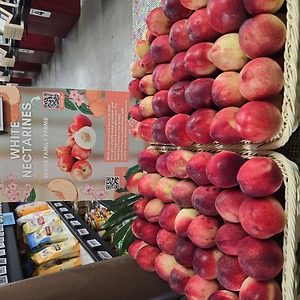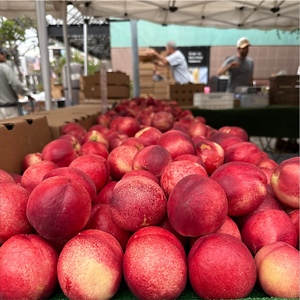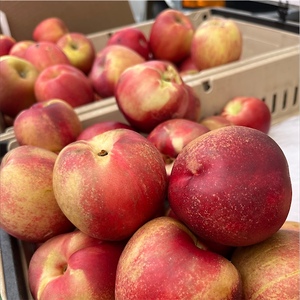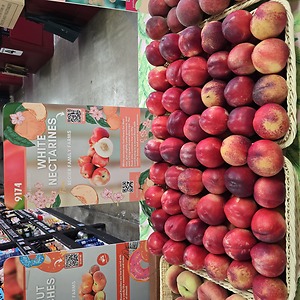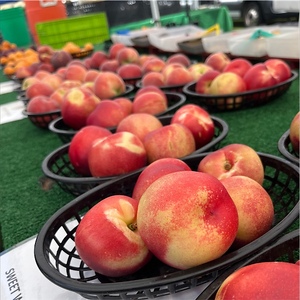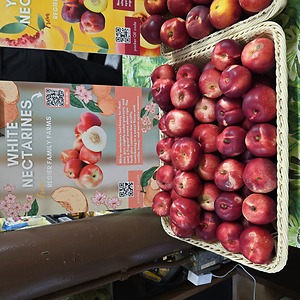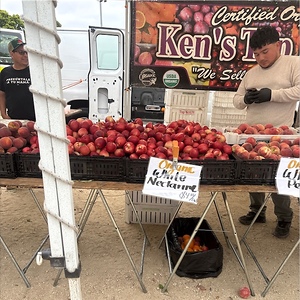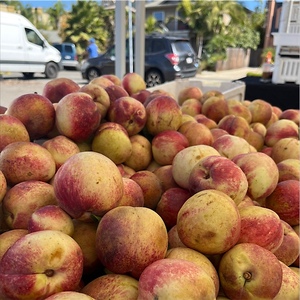

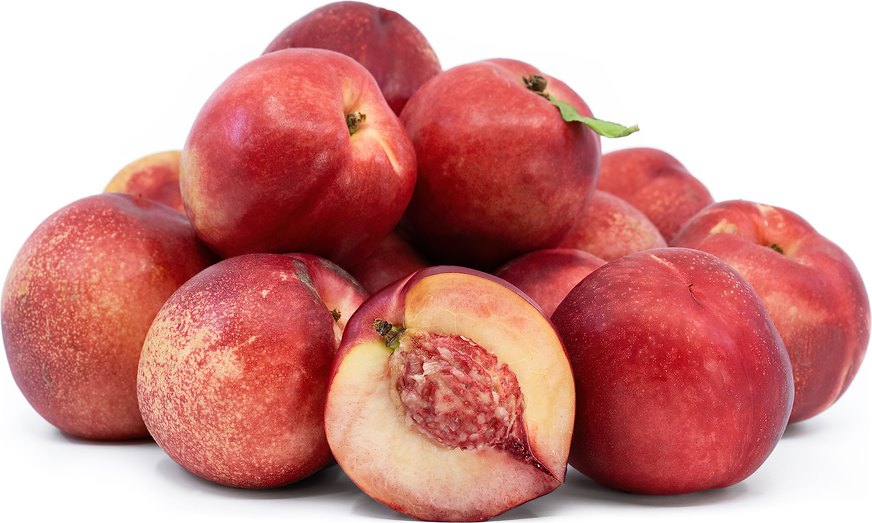
White Nectarines
Estimated Inventory, 8 lbs : 0
Description/Taste
White nectarines are small fruits, averaging 5 to 7 centimeters in diameter, and have a round, oval, to heart-like shape with a prominent central seam or suture extending lengthwise from the stem to the base. The nectarine’s skin is smooth, taut, and thin with a white base, covered in red-pink blush. It is important to note that the red and pink hues are not an indication of ripeness, but if the white base coloring bears a green tone, it may signify that the fruit has been harvested early. Underneath the surface, the white flesh is aqueous, succulent, and semi-firm, with a soft, tender consistency when ripe. There may also be red hues streaked throughout the flesh, depending on the variety, especially around the central stone. The light brown stone can either be a freestone, easily removed from the flesh, or a clingstone, tightly adhered to the flesh. White nectarines feel heavy for their size, give slightly under pressure, and emit a fragrant aroma when ripe. The flesh also contains low acidity, contributing to a sweet flavor with vanilla, honey, and warm spice nuances.
Seasons/Availability
White nectarines are available in the late spring through summer.
Current Facts
White nectarines, botanically classified as Prunus persica var. nucipersica, is a general descriptor used for pale-fleshed stone varieties belonging to the Rosaceae family. The small fruits were discovered growing as a natural mutation of peaches and share almost an identical genetic profile, except for a recessive gene that develops their signature smooth and fuzz less skin. The fruits are also distinguished from yellow nectarine varieties by containing lower acidity, giving the flesh a sweeter, less tart flavor. There are many different varieties of White nectarines cultivated worldwide, including Jade, Emeraude, Arctic Jay, Honey May, Arctic Rose, Heavenly White, Zephyr, Redgold, Polar Lights, and Arctic Queen. White nectarines have historically been considered a specialty type of stone fruit, only available for a short season in the late spring through early summer, but new varieties have been bred over time to extend the fruit’s commercial availability. White nectarines are primarily consumed fresh and are favored by stone fruit enthusiasts for their honeyed sweetness.
Nutritional Value
White nectarines are a good source of vitamin C to boost the immune system and folate to develop red blood cells for oxygen transport. The fruits also contain vitamin K to promote faster wound healing, calcium and phosphorus to strengthen bones and teeth, and antioxidants to protect the cells against free radical damage, including the polyphenol gallic acid, which contains anti-inflammatory properties.
Applications
White nectarines have a delicate, sweet flavor best suited for fresh eating. The skin and flesh are edible and can be eaten straight, out of hand, or sliced and tossed into green salads. White nectarines can also be chopped into salsa, diced for bruschetta, mixed into yogurt and cereal, used as a fresh topping over desserts, incorporated into fruit salad, or stirred into grain bowls. In addition to culinary dishes, White nectarines can be blended and frozen into popsicles, used in smoothies, sliced and mixed into fruit punches, lemonades, and sparkling beverages, or pureed and used to flavor cocktails. Beyond fresh preparations, the sugar content and low acidity give the fruits a sweeter taste for simmering into jams, jellies, compotes, syrups, and sauces. White nectarines can also be poached in fragrant syrups, grilled and served with ice cream, broiled for a savory-sweet dessert, or baked into muffins, cakes, galettes, cobbler, crisps, and tarts. White nectarines pair well with cheeses such as burrata, goat, and manchego, herbs including basil, cilantro, and lavender, prosciutto, seafood such as shrimp, fish, and scallops, arugula, tomatoes, corn, and fruits such as strawberry, raspberry, lychee, apricots, and peaches. Whole, unwashed White nectarines should be kept at room temperature until ripe. Once ready to eat, the fruits should be immediately consumed for the best quality and flavor or stored for an additional couple of days in the refrigerator. White nectarines can also be dried, canned, or frozen for extended use.
Ethnic/Cultural Info
California is the top producer of peaches and nectarines in the United States, and nectarines became a widely cultivated fruit in the 1950s. During this time, nectarines were selectively bred to showcase slightly firmer flesh and improved hardiness, making the fruits more suitable for transport to markets across the United States. In the modern-day, stone fruit season is widely celebrated throughout California as the season is short but filled with many different varieties of peaches, pluots, nectarines, apricots, and plums. In Clovis, a city in Central California within Fresno County, an Organic Stone Fruit Jubilee is held annually to celebrate the local farms that grow specialty stone fruits within the city. The jubilee features vendor booths with fresh stone fruits for sale, and visitors can sample and learn about the diverse varieties of each type of fruit. The event is also meant to be an educational experience for visitors to learn about the city, local agriculture, and the importance of farm-grown fruits.
Geography/History
White nectarines are believed by experts to be native to Central Asia and China, where the fruits were discovered growing as a natural mutation of peach trees. Genetic studies have concluded that nectarines evolved to contain a recessive allele, becoming a fuzz-free peach. Once the fruits were discovered and favored for their smooth skin, bud mutations were isolated and planted as second-generation trees to produce the new fruits. White nectarines were spread across Central Asia via trade routes in the Early Ages and were cultivated by the Ancient Roman and Greek Empires. In the 16th century, White nectarines were introduced to England and Northern Europe, and the fruits were brought to the New World with colonists. White nectarines were notably popular during the 1800s, but the fruits eventually fell out of favor due to their lack of transportability and became a specialty fruit grown by farmers in California. In the late 20th century, breeder Floyd Zaiger created improved White nectarine varieties to reinspire commercial markets to carry the white-fleshed fruits. Today White nectarines still naturally occur as bud mutations on peach trees in orchards worldwide, and the trees thrive in a climate with cold weather during the winter to develop healthy buds and a hot, dry spring and summer for fruit to ripen. White nectarine cultivation occurs in both the Northern and Southern hemispheres in Asia, Australia, Europe, North America, and South America, and when in season, the fruits can be found through local markets and select distributors and grocery stores.
Recipe Ideas
Recipes that include White Nectarines. One



